|
Category
|
Samarkand Museum of local lore
The official date of opening of the Museum is 1896. Top of the natural history collection charges laid a member of the Russian Geographical Society, an amateur historian, and explorer of Central Asia, Captain Barshchevsky, Moscow merchant Reshetnikov and military governor Earl Rostovtsev. All the rooms of the museum located in a row, forming a suite. Its main exhibits are the history and nature of the Samarkand region. And the museum's collection of unique artifacts can compete with larger funds of museums of Uzbekistan, despite its regional status. On the ground floor of the exposition, which covers the history of the region from ancient times to the beginning of XX century.
The Bronze Age and Iron is widely illustrated with photographs of rock art. The period from VIII to IV centuries BC, presented a pottery - cups of fine form, as well as coins. Complements the colorful exhibit a copy of a painting by artist V. Kaydalov "Spitamen Rebellion". Kushan period (IV-I century AD), characterized by economic expansion, the development of irrigation, various kinds of handicrafts, the rise of urban life, represented by coins of the Kushan kings. In the early Middle Ages, the exhibition - a diverse domestic and ritual pottery, Sogdian coins and elegant women's jewelry, as well as items grave goods, weapons (sword) from the mounds Akdjartepa, Sazagan, Agalyksay.
The period of Islamic revival represented a variety of products made from metal, glass and ceramics, including a fragment of an Egyptian vessel of red glass, luster ceramics from the Iranian city Ray, an abundance of different coins. The exhibition also presents tips Mongol arrows, Figure Samarkand citadel. During the reign of Amir Temur and his dynasty represented material from excavation - sets of metal, bone, glass, and coins of the thirteenth and sixteenth centuries, which give an idea of handicrafts, the caravan trade and commodity-money relations Timurid era. Here are the rarest pieces - military and ceremonial drum nobility fifteenth and sixteenth centuries. As well as a unique book De Sanctien "History of Temur", published in 1678 in Amsterdam. In the exhibition you can see the reconstruction of the famous observatory of Ulugbek, executed by architect V. Nielsen, as well as photos of the preserved part of the grand astronomical instrument - quadrant (sextant). Unique exhibit of collection is a coffin of Amir Timur. As you know, the formidable ruler of the seriously ill and died during the campaign, and to deliver the body to Samarkand, took to embalm it and put in the coffin, despite Muslim custom. But the circumstances demanded. When a group of Soviet scientists in 1941 revealed the coffin for Anthropological Research, the smell of balsam spread over the dungeon. In 1942, the remains of Tamerlane was buried in the same place, but without the coffin.
The museum reflects the theme of the struggle for the independence of peoples of the region, the Sogdians national liberation struggle led by the Spitamen against the Greek-Macedonian army, fighting against the Arab conquerors of the people under the leadership of Mukanna, "Sarbadars" insurrection in Samarkand against the Mongol invaders, the national liberation struggle against the colonial policy of tsarist Russia.
The traditional Jewish quarter in Samarkand was situated in the Old town to the east of Registan Square in the vicinity of the ancient cemetery Chokardiza. Here and now kept separate building of the Jewish community and synagogue. An extensive collection gathered here in 1920-1930's. includes about 2,000 items: handwritten and lithographed books in Hebrew, photos of 20's and 30's., the Torah scrolls in the Samarkand paper and leather, Easter attributes, samples of clothing. In preparation for the 2750th anniversary of Samarkand in 2007 opened a website www.samarkandfund.org, where on the initiative of Fazylov created a database of Jewish cemeteries in Samarkand (11,000 graves). Another important part of the exhibition is the museum department of nature. Here is the region's flora and fauna, geology and paleontology of the edge, a collection of minerals and minerals found in the Samarkand region. The most interesting are the collection of stuffed birds and entomological collection. The ornithological collection is part of the zoological collections of the Museum. The bulk of the collection consists of well-known Uzbek charges ornithologist Bogdanov, who worked at the Museum since the late 30s to mid 70s of last century. Currently, the collection of ornithological collections of the Samarkand Regional History Museum presents 858 copies.
In addition, the exhibition presents a landscape by, for example, shows the sandy desert, mountains, riparian forest. Also in this section is a stand dedicated to nature conservation in Uzbekistan, and Samarkand region, in particular. On the second floor is an exhibition "Samarkand and Samarkand in the years of independence", about the life and achievements of the economy, culture and sports over the years of independence. As you know, Samarkand - a unique city-reserve, much attention is paid to the protection and restoration of ancient monuments. The museum presents material on the Hero of Uzbekistan - restorer Mirumar Asadov. Visiting this museum will give you plenty of experience and knowledge of our beautiful province. In preparing the articles used material sites http://www.zool-col.uz, http://eajc.org and http://touruz.com |
 In one of the most picturesque streets of Samarkand, in an old mansion, once owned by a rich merchant Kalantarov Abram built in the early XX century by the architect E.O.Nelle in the eclectic style, is located the Museum of local lore. The museum building is an architectural monument and is protected by the state.
In one of the most picturesque streets of Samarkand, in an old mansion, once owned by a rich merchant Kalantarov Abram built in the early XX century by the architect E.O.Nelle in the eclectic style, is located the Museum of local lore. The museum building is an architectural monument and is protected by the state.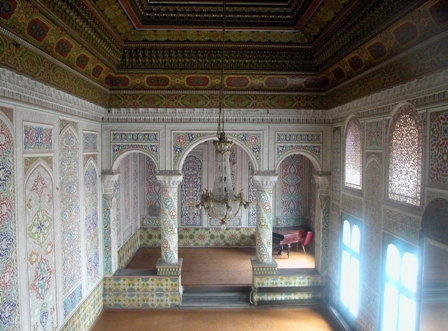 Mesolithic-Neolithic, Eneolithic - the final stages of primitive society is characterized by a variety of purposes, and fragments of stone tools first molded ceramics found in archaeological research in the Samarkand region.
Mesolithic-Neolithic, Eneolithic - the final stages of primitive society is characterized by a variety of purposes, and fragments of stone tools first molded ceramics found in archaeological research in the Samarkand region.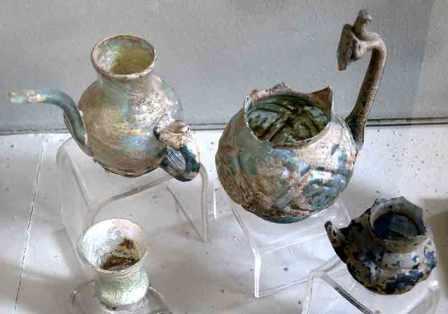 The exhibition devoted to the period of the Arab conquest of Sogdian a presented copies of beautiful paintings of the palace fort of Afrasiab, picture-reconstruction "Sogdian warriors", the sword and arrow tips Sogdian, various utensils and ornaments.
The exhibition devoted to the period of the Arab conquest of Sogdian a presented copies of beautiful paintings of the palace fort of Afrasiab, picture-reconstruction "Sogdian warriors", the sword and arrow tips Sogdian, various utensils and ornaments.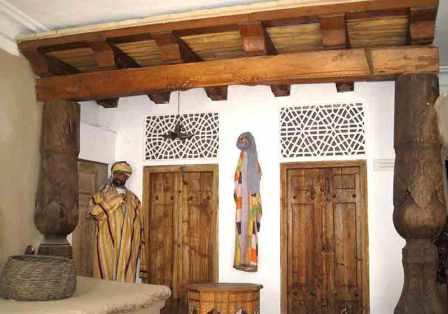 Of great interest to visitors are the interiors of the house of a large landowner of XIX century. The house was divided into two halves, male - "tashkari" and a female - "ichkari." Here is a wealth of ethnographic material: clothing, embroidery, and household utensils. This is a fascinating story about the traditional national culture, customs and rituals with authentic objects of decorative art.
Of great interest to visitors are the interiors of the house of a large landowner of XIX century. The house was divided into two halves, male - "tashkari" and a female - "ichkari." Here is a wealth of ethnographic material: clothing, embroidery, and household utensils. This is a fascinating story about the traditional national culture, customs and rituals with authentic objects of decorative art.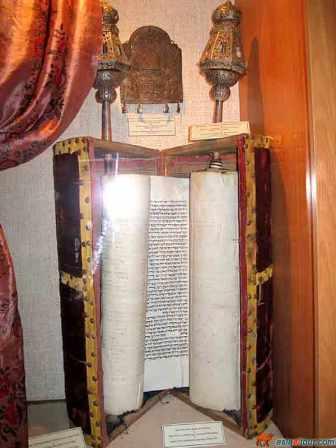 In June 2008 the museum opened exhibition "Jews in the region, past and present". The exhibition includes archival documents and materials collected by scholars Isaac Lurie. Here are old photographs, books, paintings paintings, costumes and objects of everyday life and culture of local Jews. Also, visitors can get acquainted with the history of the quarter "Yahudiyon", which was established in Samarkand in 1843.
In June 2008 the museum opened exhibition "Jews in the region, past and present". The exhibition includes archival documents and materials collected by scholars Isaac Lurie. Here are old photographs, books, paintings paintings, costumes and objects of everyday life and culture of local Jews. Also, visitors can get acquainted with the history of the quarter "Yahudiyon", which was established in Samarkand in 1843.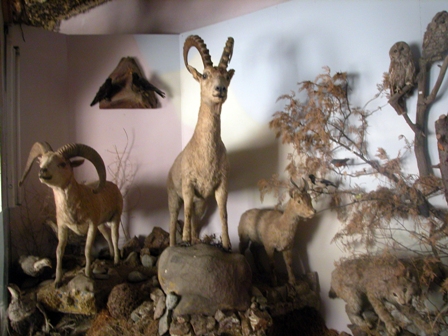 Theriological collection is part of the zoological collections of the Museum of Nature. As in the ornithological collection, most of the charges belong to A. Bogdanov and P.F. Rypl made by them during the research area of Samarkand. The funds and the database Theriological collection includes 146 specimens of mammals belonging to 46 species or 42.9% of all mammal species diversity in Uzbekistan.
Theriological collection is part of the zoological collections of the Museum of Nature. As in the ornithological collection, most of the charges belong to A. Bogdanov and P.F. Rypl made by them during the research area of Samarkand. The funds and the database Theriological collection includes 146 specimens of mammals belonging to 46 species or 42.9% of all mammal species diversity in Uzbekistan.














